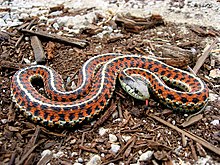Western terrestrial garter snake
| Western terrestrial garter snake | |
|---|---|

| |
| T. elegans terrestris | |
| Scientific classification | |
| Domain: | Eukaryota |
| Kingdom: | Animalia |
| Phylum: | Chordata |
| Class: | Reptilia |
| Order: | Squamata |
| Suborder: | Serpentes |
| Family: | Colubridae |
| Genus: | Thamnophis |
| Species: | T. elegans
|
| Binomial name | |
| Thamnophis elegans | |
| Subspecies | |
|
6 sspp., see text | |
| Synonyms | |
| |
The western terrestrial garter snake (Thamnophis elegans) is a western North American
Description
Most western terrestrial garter snakes have a yellow, light orange, or white dorsal stripe, accompanied by two stripes of the same color, one on each side. Some varieties have red or black spots between the dorsal stripe and the side stripes. It is an immensely variable species, and even the most experienced herpetologists have trouble when it comes to identification. They are medium-sized snakes, usually 46–104 cm (18–41 in).
Like many species of North American garter snake, the western terrestrial garter snake possesses a mildly venomous saliva. Specimens collected from Idaho and Washington produced venom with myonecrotic (muscle tissue-killing) effects when injected into the gastrocnemius muscles of mice.[3] Several cases of mild human envenomation with local edema and other symptoms (but without any systemic symptoms) have occurred from the wandering garter snake subspecies, including in Colorado.[4][5]
This species is the only garter snake species with a well-documented tendency to constrict prey, although the constriction is inefficient when compared with the constriction of many other snakes (such as the
Geographic range
Thamnophis elegans is found in central
Subspecies

Six subspecies have been identified, although the validity of some of them is debated.[2]
- Thamnophis elegans arizonae Tanner & Lowe, 1989 – Arizona garter snake
- Thamnophis elegans elegans (Baird & Girard, 1853) – mountain garter snake
- Thamnophis elegans hueyi San Pedro Mártirgarter snake
- Thamnophis elegans terrestris Fox, 1951 – coastal garter snake
- Thamnophis elegans vagrans (Baird & Girard, 1853) – wandering garter snake
- Thamnophis elegans vascotanneri Tanner & Lowe, 1989 – Upper Basin garter snake
Habitat
Thamnophis elegans occurs in a wide variety of habitats, including grasslands, woodlands, and coniferous forests, from sea level up to 3,962 m (12,999 ft). It is primarily terrestrial, although populations in the Great Basin and Rocky Mountains are semi-aquatic.[8]
Reproduction
The western terrestrial garter snake does not lay eggs, but instead is
Diet
The diet of Thamnophis elegans depends heavily on the prey available in the local area, and thus varies due to regional geographical differences. This makes the western terrestrial garter snake an excellent example of polyphagism—the adaptation of an organism to maintain a varied diet.
Coastal populations' food sources mainly include terrestrial prey such as earthworms, grubs, caterpillars, crickets, small snails, slugs, salamanders, baby rodents (such as small ground squirrels and other mammals) and small lizards or toads. By comparison, inland and montane populations prefer a far more “amphibious” diet of small frogs, newts, salamanders, toads and their larvae, as well as freshwater leeches, earthworms and small fish.[12] Thus, aquatic food sources are a staple in the inland snake populations' diet.
Coastal snakes are less likely to respond to chemical cues received from fish, which can be inferred by less rapid tongue-flicking when around them.[11] They are also less likely to attack and ingest fish. This preference in diet is so strong that the snake will starve before eating non-preferred prey types.[11] Further, this appears to be genetically determined as this variation in diet is observed in newborn snakes from both populations.[10] When hunting, the Western Garter Snake's actions are chemically and visually mediated on land and in water.[12] Regardless the habitat in which foraging takes place, both ecotypes utilize similar techniques. This consists of attacks that are both aerial and underwater.[11] These include craning, cruising, and diving. However, coastal snakes are less likely to participate these activities.[11]
These differences in diet and foraging behavior between coastal and inland snake populations suggest that the species has undergone microevolution. Due to dietary and foraging differences between variants of T. elegans, it can be inferred that coastal populations have filled a niche in the environment that allows them to no longer rely on fish as a major food source.[11]
References
- ^ . Retrieved 11 November 2021.
- ^ a b Thamnophis elegans at the Reptarium.cz Reptile Database. Accessed 12 December 2014.
- JSTOR 1564384.
- PMID 8185110.
- PMID 7273669.
- ^ JSTOR 1565963.
- ^ Gregory, Patrick T.; Macartney, J. Malcolm; Rivard, Donald H. (1980). "Small mammal predation and prey handling behavior by the wandering garter snake Thamnophis elegans". Herpetologica. 36 (1): 87–93.
- ^ ISBN 0395982723.
- ^ Schmidt, K.P. and D.D. Davis. (1941). Field Book of Snakes of the United States and Canada. G.P. Putnam's Sons. New York. p. 246.
- ^ S2CID 38341468.
- ^ S2CID 34175574.
- ^ a b Whitaker, Jake. "Thamnophis elegans Western Terrestrial Garter Snake". Animal Diversity Web. University of Michigan Museum of Zoology. Retrieved October 23, 2014.
External links
 Media related to Thamnophis elegans (category) at Wikimedia Commons
Media related to Thamnophis elegans (category) at Wikimedia Commons

